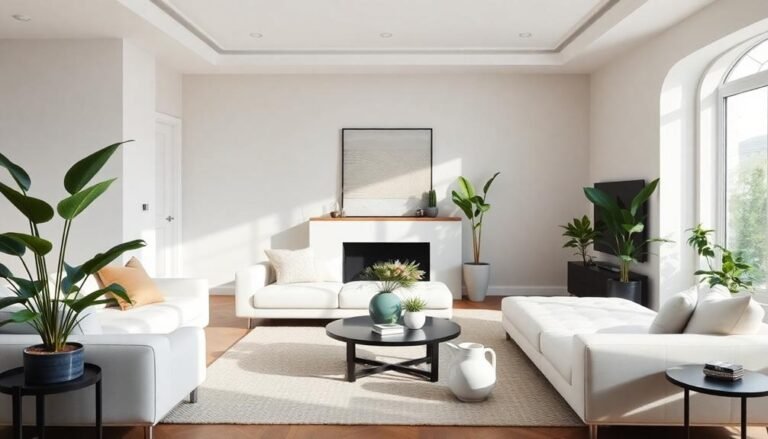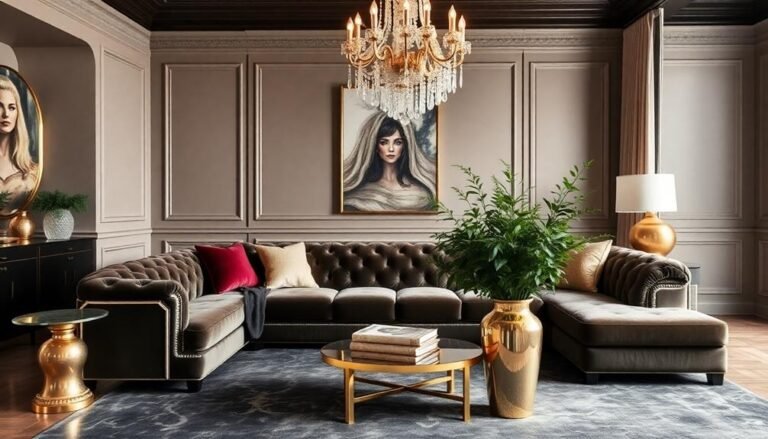To mix and match home decor styles like a pro, start by understanding different styles, such as rustic, contemporary, and eclectic. Establish a cohesive color palette with three to five colors that tie your pieces together. Don't forget to mix textures; balance sleek and cozy materials for visual appeal. Consider proportions—group large furniture with smaller decor and incorporate varied heights to create interest. Confidently mix patterns and introduce statement pieces that showcase your personality. Finally, create functional zones that enhance your space's usability. By following these principles, you'll elevate your decor and discover fresh ideas to inspire your style.
Understanding Different Decor Styles
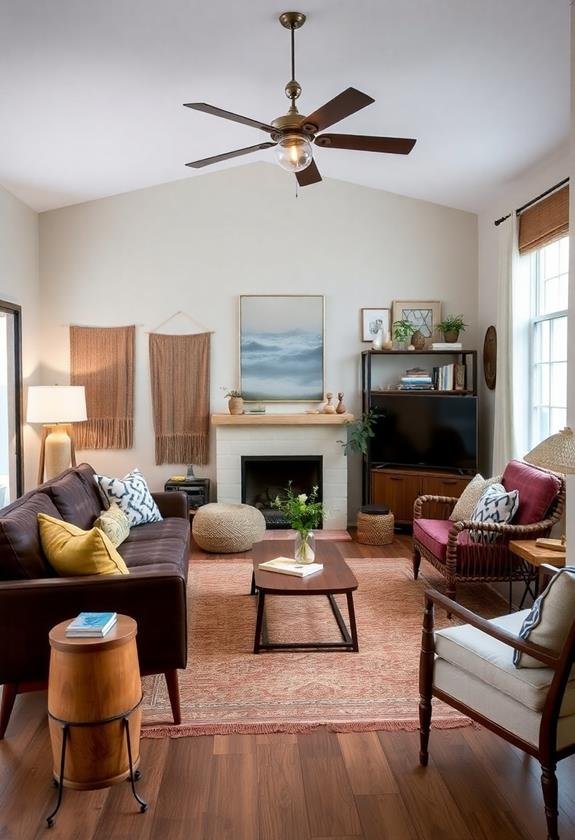
When you plunge into home decor, it's essential to grasp the various styles that can shape your space. Each decor style has its own unique characteristics, offering different vibes and atmospheres. For instance, if you're drawn to a cozy, inviting feel, you might lean towards a rustic style, which incorporates natural materials like wood and stone. On the other hand, if you prefer sleek and modern aesthetics, a contemporary style with clean lines and minimalistic designs might be more your speed. To create a stunning atmosphere, consider how quality bedding and furniture can enhance your chosen decor style. You might also find yourself enchanted by the charm of vintage decor, which celebrates the beauty of bygone eras through antiques and retro pieces. Don't forget about eclectic styles, which allow you to blend various influences, showcasing your personality and creativity.
Understanding these different styles can be the first step toward creating a space that feels uniquely yours. Imagine the possibilities as you mix elements from various styles; maybe a mid-century modern chair complements your rustic wooden table. By recognizing what resonates with you, you'll be better equipped to curate a harmonious atmosphere that reflects your taste while ensuring each piece has its rightful place.
Establishing a Cohesive Color Palette

A well-chosen color palette can transform your home decor, creating a sense of unity and flow throughout your space. To establish a cohesive color scheme, start by selecting a few key colors that resonate with you. Consider incorporating budget-friendly decor options that complement your chosen hues. Think about the mood you want to evoke and how different shades influence feelings.
Consider these essential tips when crafting your palette:
- Choose a base color: This will be the primary hue that appears most frequently in your space, setting the tone.
- Add accent colors: Select two or three complementary shades to create depth and interest, ensuring they harmonize with your base color.
- Limit your palette: Aim for three to five colors to avoid overwhelming the eye, allowing for a more sophisticated look.
- Test samples: Paint swatches on your walls or use fabric swatches to see how colors interact with your existing decor and lighting.
Finding Common Ground in Textures
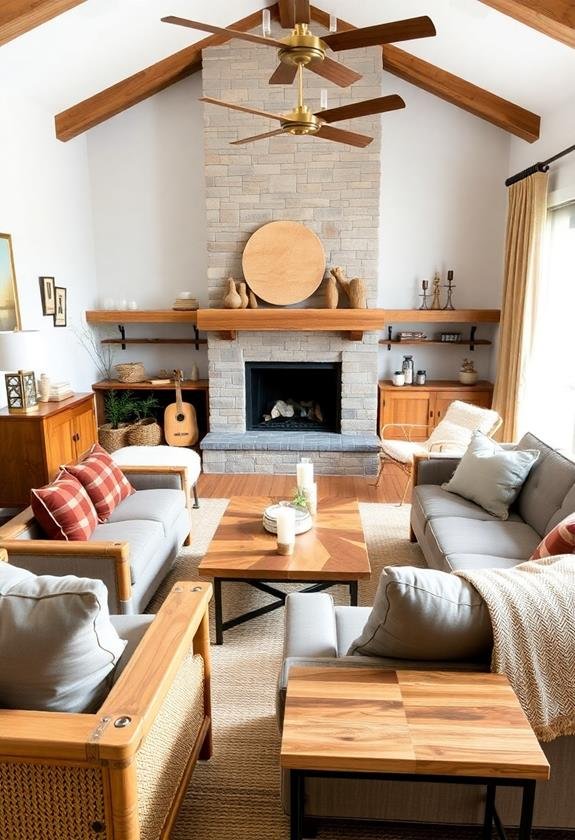
Textures play an essential role in defining the character of your home decor, adding layers of visual interest and tactile appeal. When mixing different styles, it's crucial to find textures that complement one another, creating a cohesive look without overwhelming the senses. For instance, if you're incorporating sleek modern elements, consider adding warmth with softer fabrics like velvet or wool. This blend can soften the starkness of modern pieces, making your space feel inviting. Additionally, incorporating decorative storage baskets, like those made from cotton rope or linen, can introduce both texture and functionality to your space, while also keeping it organized and clutter-free. Top decorative storage options can enhance your decor while offering practical solutions.
Think about the textures present in your current decor. Are there smooth surfaces that could benefit from the touch of a woven basket or a chunky knit throw? Such additions can create a harmonious balance, inviting guests to engage with your space on multiple levels. You might also explore contrasting textures, such as combining shiny metals with rustic wood, which can create an intriguing visual dynamic.
Remember that consistency is key; aim for a common theme or palette in textures to unify your decor. Whether it's through textiles, finishes, or materials, finding common ground in textures will help your home feel well-curated and thoughtfully designed, allowing your unique style to shine through effortlessly.
Balancing Proportions and Scale
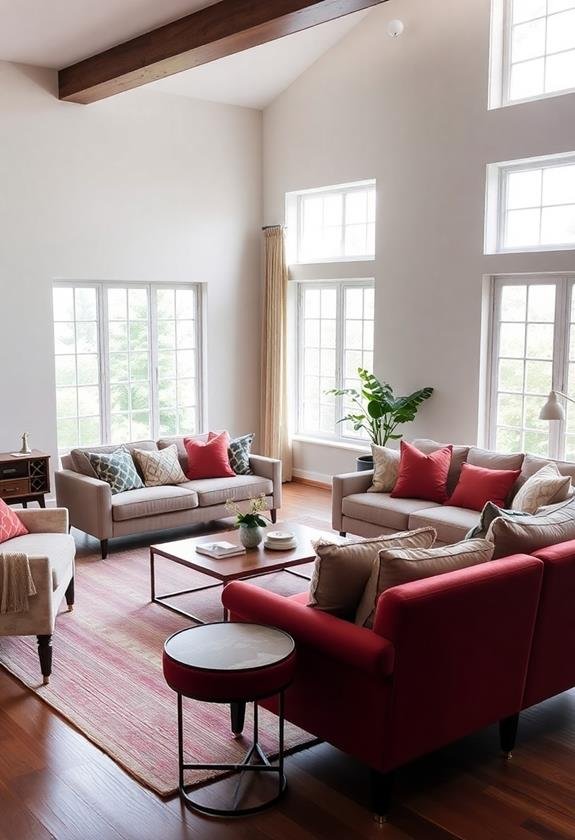
Finding the right balance of proportions and scale can transform your space from chaotic to harmonious. When you're mixing different decor styles, it's essential to reflect on how the size and shape of each piece interact with one another. A large, bold piece can dominate a space, while smaller items may get lost. Aim for a mix that feels cohesive, ensuring that no single element overwhelms the others.
To achieve this balance, keep these tips in mind:
- Group items by size: Pair larger furniture with smaller decor for a balanced look.
- Vary heights: Incorporate a mix of low, medium, and tall pieces to create visual interest.
- Use negative space: Allow areas of blank space to breathe, preventing overcrowding.
- Create focal points: Establish one or two standout pieces that draw the eye, providing a sense of direction in your design.
Mixing Patterns With Confidence
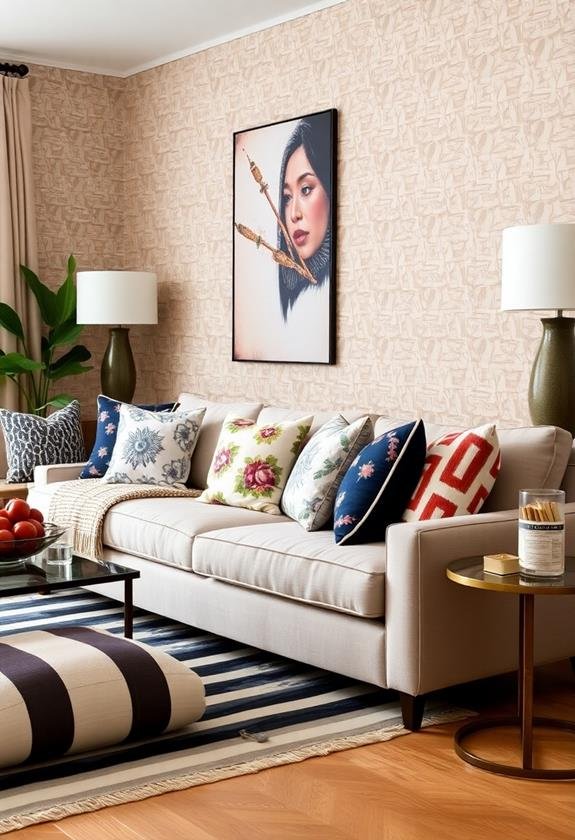
When it comes to mixing patterns, many people feel uncertain, but embracing this design challenge can lead to stunning results. Start by selecting a color palette; this will unify your patterns and create a cohesive look. Aim for a mix of different scales—pair a large floral print with a smaller geometric design. This contrast not only adds visual interest but also prevents your space from feeling chaotic.
Next, consider the type of patterns you want to include. Stripes, florals, and plaids can work beautifully together if you keep your color scheme consistent. For instance, a bold striped sofa can pair well with a delicate floral pillow, adding depth without overwhelming the eye. You could also use a solid color as a grounding element; this allows your patterns to shine while providing a necessary balance.
Incorporating Statement Pieces
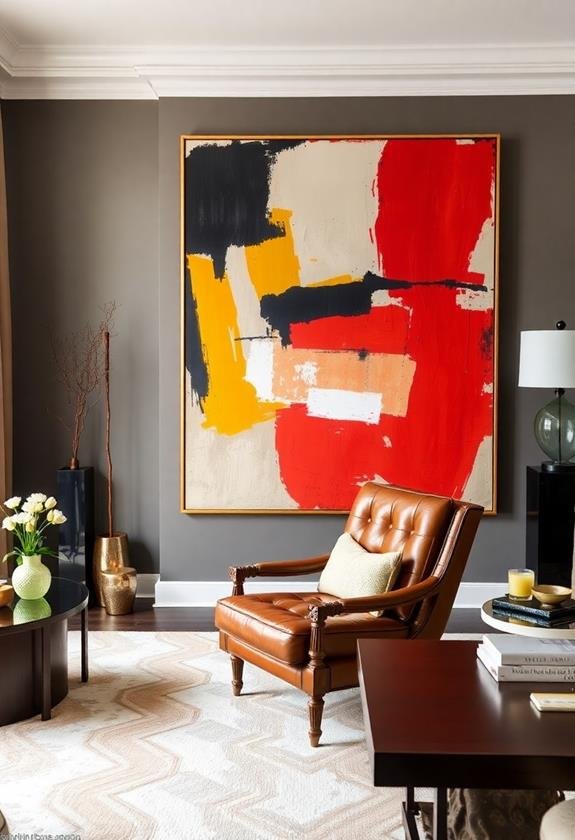
Incorporating statement pieces can instantly elevate your home decor and set the tone for your space. These bold elements draw the eye and create focal points, giving your room character and style. Whether it's a striking piece of art, an oversized piece of furniture, or an unusual accessory, statement pieces serve as conversation starters and personal expressions of taste.
To effectively incorporate these standout items, consider the following:
- A large artwork that complements your color palette and adds visual intrigue.
- An eye-catching light fixture that not only illuminates but also enhances the overall ambiance.
- A unique furniture piece, such as a vintage chair or a contemporary coffee table, that contrasts with your existing decor.
- A decorative rug that ties the room together, providing texture and warmth while grounding your design.
When you thoughtfully select and position these statement pieces, you create a harmonious blend of styles. Confirm that each item reflects your personality and resonates with the overall theme of your space. By doing this, you'll achieve a cohesive look that feels curated and inviting, making your home a true reflection of who you are.
Creating Functional Zones
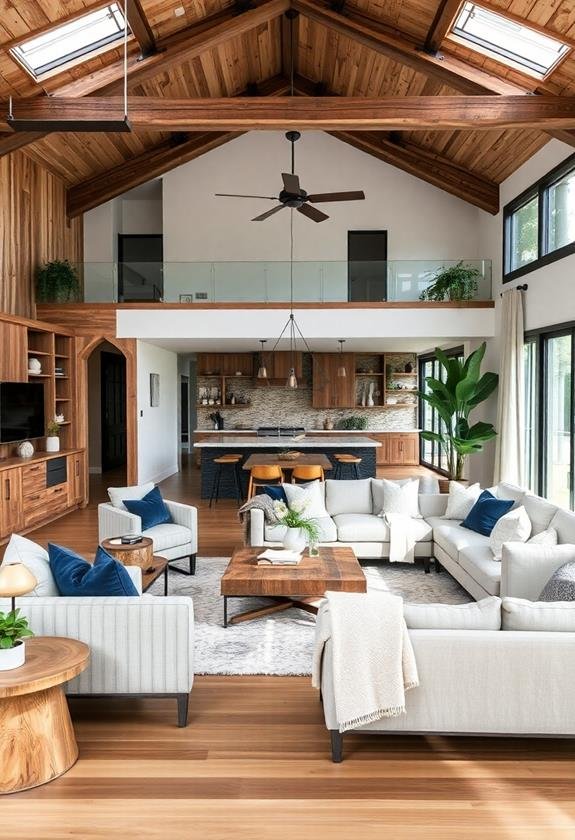
Creating functional zones transforms your living space into an organized and purposeful environment. By defining areas for specific activities, you not only enhance the functionality of your home but also create a sense of flow and harmony. Start by evaluating how you use your space daily. For example, if you love reading, carve out a cozy nook with a comfortable chair, good lighting, and a small side table for books.
Next, consider your living room. You can separate a conversation area from an entertainment zone by using area rugs or furniture placement. This way, you encourage different activities without feeling cluttered.
In the kitchen, arrange zones for cooking, dining, and even a small workspace. Place utensils and cooking tools together for easy access, and set up a dining area that invites family gatherings.
When you create these zones, think about the decor styles you're mixing. Use complementary colors and textures to maintain a cohesive look while ensuring each zone feels distinct and functional. Ultimately, these zones not only enhance your home's aesthetic but also make daily living more enjoyable and efficient.
Personalizing Your Space
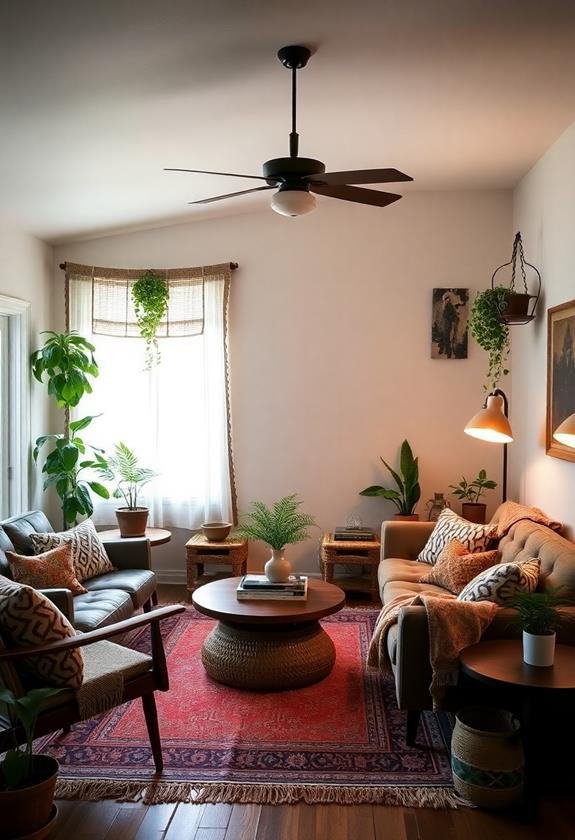
Personalizing your space is all about infusing it with your unique style and personality, turning a house into a home. Every detail matters, from the colors you choose to the art you display. To truly make your space feel like yours, think about incorporating elements that resonate with your experiences and values. You can achieve this by blending different decor styles while emphasizing your personal touch.
Here are some ideas to help you personalize your space:
- Incorporate family heirlooms: These pieces not only tell a story but also connect you to your past.
- Showcase your hobbies: Whether it's a collection of vintage cameras or vibrant paintings you've created, let these interests shine through.
- Use meaningful colors: Choose a color palette that evokes emotions and memories, creating a soothing or energizing atmosphere.
- Add personal artwork: Hang photos from travels or artwork that inspires you to spark conversations and reflect your journey.
Learning From Professional Designers
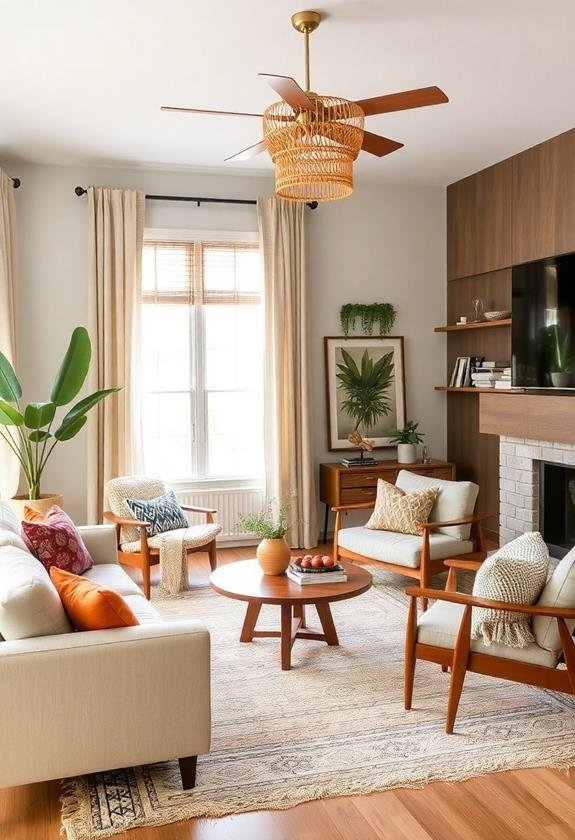
Professional designers have a wealth of knowledge that can enhance your approach to mixing and matching home decor styles. By studying their techniques, you can learn how to create a cohesive look that feels both intentional and personal. One key lesson is understanding color theory; designers often use a color palette to guide their choices, ensuring that even contrasting styles can harmonize.
Additionally, professional designers emphasize the importance of balance. For instance, if you have a sleek modern sofa, pairing it with vintage accessories can create an intriguing contrast, but be mindful of proportions. Too many bulky items can overwhelm a room.
Don't shy away from experimenting; designers often play with textures and patterns. Think about how a plush rug can soften a space with industrial furniture, or how geometric prints can complement softer, organic shapes.
Frequently Asked Questions
How Do I Choose a Dominant Decor Style for My Space?
To choose a dominant decor style for your space, start by identifying your preferences. Consider factors like color schemes, textures, and furniture shapes that resonate with you. Next, explore various styles—whether it's modern, rustic, or eclectic. Create a mood board with images that inspire you. This visual aid will help clarify your vision. Finally, make certain your chosen style complements your space's architecture and layout, allowing for a cohesive and inviting atmosphere.
Can I Mix Modern and Vintage Pieces Seamlessly?
Imagine a dance between two worlds, where modern sleekness twirls with vintage charm. You can absolutely mix modern and vintage pieces seamlessly, as their contrasts can create a harmonious atmosphere. Start by selecting a unifying color palette that ties both styles together. Incorporate modern furniture with vintage accessories, or use a vintage piece as a statement that draws attention. This blend adds character and depth, making your space truly unique and inviting.
What Are Some Common Mistakes to Avoid When Mixing Styles?
When mixing different styles, you should avoid a few common mistakes. First, don't overlook scale; mismatched sizes can create visual chaos. Second, avoid too many contrasting colors; choose a cohesive palette instead. Finally, steer clear of overloading a space with decor; it's better to curate a few statement pieces. By being mindful of these pitfalls, you'll create a harmonious and inviting environment that reflects your unique taste without feeling cluttered or disjointed.
How Do I Ensure My Space Doesn't Look Cluttered?
To keep your space from resembling a chaotic thrift store, start by choosing a cohesive color palette. Limit your accessories, focusing on a few standout pieces rather than a sea of knick-knacks. Utilize furniture with dual purposes to save space, and guarantee each item has a designated spot. Remember, negative space can be your friend; it allows the eye to rest and creates a more open atmosphere. Balance is key, so don't overcrowd!
Are There Specific Color Combinations That Work Universally?
Yes, certain color combinations tend to work universally well. For instance, pairing navy blue with soft gray creates a sophisticated look, while crisp white and pastel shades offer a revitalizing vibe. Earthy tones like terracotta and olive green evoke warmth and comfort. When choosing colors, consider the mood you want to convey; harmonious palettes can make a space feel cohesive and inviting, ensuring your decor feels intentional rather than chaotic or mismatched.


